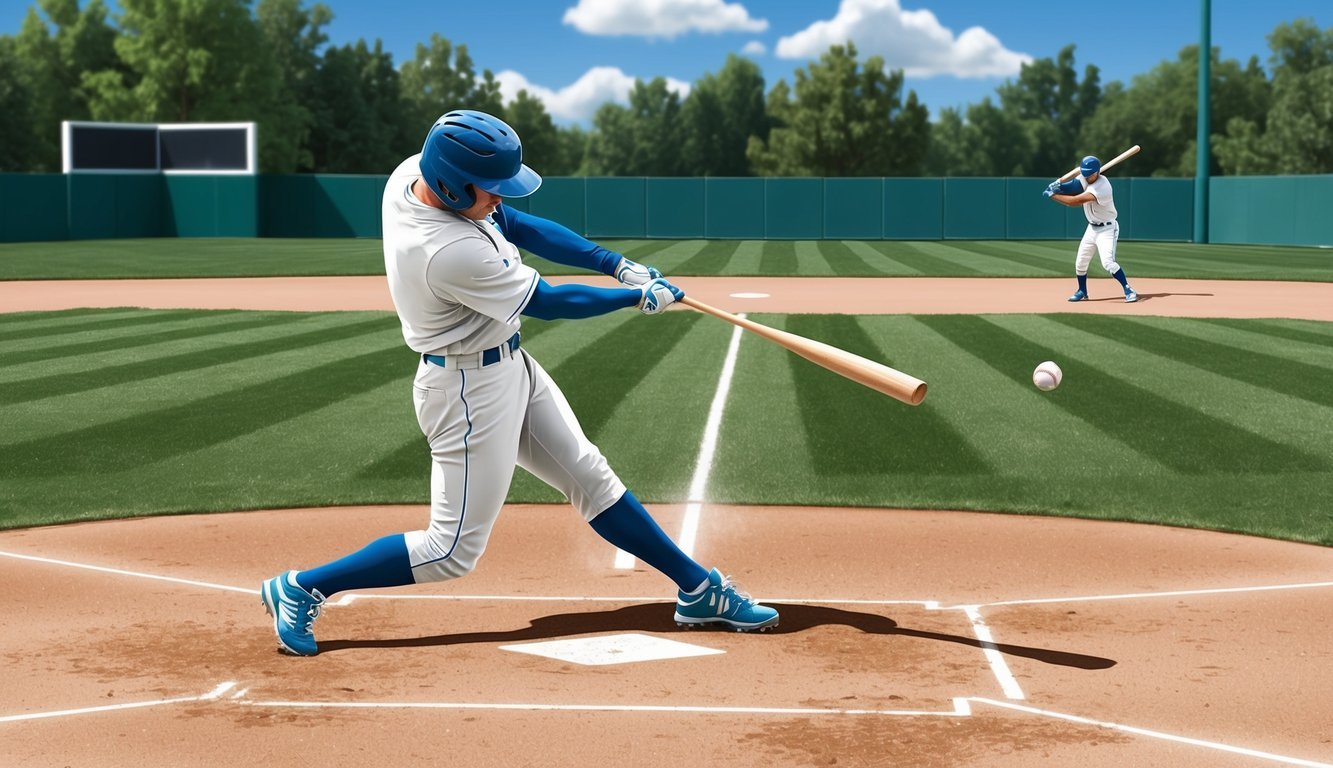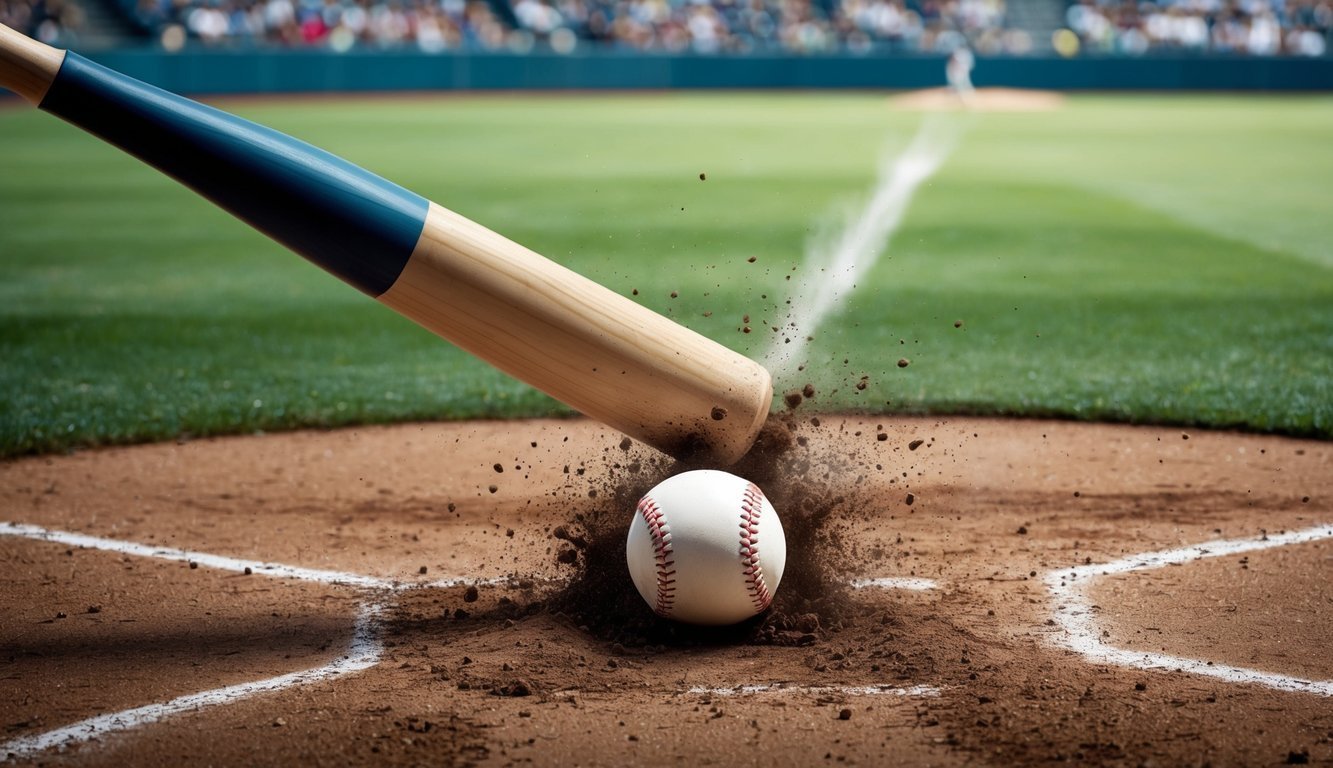Baseball players always look for ways to improve their hitting skills.
One popular training tool that has gained traction in recent years is the baseball hitting stick.
This simple yet effective device helps batters refine their swing mechanics and develop better hand-eye coordination.
A baseball hitting stick is a lightweight, portable training aid designed to simulate the motion of hitting a pitched ball. It typically consists of a long, flexible rod with a small ball or pad attached to the end.
Players can use it for solo practice sessions or with a partner to work on timing, bat speed, and contact point.
Hitting sticks come in various designs to suit different needs and skill levels.
Some models feature adjustable heights, while others incorporate weighted elements to build strength.
Whether you’re a Little League player just starting out or a seasoned high school athlete, a hitting stick can be a valuable addition to your training regimen.
Understanding Hitting in Baseball and Softball
Effective hitting relies on proper technique and consistent practice.
Mastering swing mechanics and adapting to the nuances of each sport can significantly improve a player’s performance at the plate.
The Importance of Swing Mechanics
Proper swing mechanics form the foundation of successful hitting in baseball and softball.
A balanced stance allows for better weight transfer and power generation.
Players should focus on grip, keeping their hands close to their body, and maintaining a level swing path.
The load and stride initiate the hitting motion.
A slight backward shift of weight prepares the body for explosive forward movement.
Timing is crucial – the stride should coincide with the pitcher’s release point.
Contact point and follow-through complete the swing.
Hitters aim to make contact in front of the plate, extending their arms fully.
A proper follow-through ensures maximum power transfer to the ball.
Regular practice with tools like hitting sticks can help refine these mechanics.
They simulate various pitch locations, allowing players to work on inside, middle, and outside swings.
Differences Between Baseball and Softball Hitting
While baseball and softball share many hitting principles, key differences exist.
Softball’s larger ball and underhand pitching style affect swing approach.
The pitch comes from a lower angle, often rising as it reaches the plate.
Softball hitters typically use a more compact swing with less stride.
This helps them adjust to the ball’s upward trajectory.
Baseball hitters, facing overhand pitches, often employ a longer stride and more pronounced weight shift.
Bat selection also differs.
Softball bats are usually longer and have a larger sweet spot.
Baseball bats are generally heavier, requiring more upper body strength.
Vision training is crucial in both sports but presents unique challenges.
Softball players must track a larger ball over a shorter distance, while baseball players face higher velocities.
Training Equipment for Enhanced Hitting
Baseball players can significantly improve their hitting skills with specialized training equipment.
These tools help develop power, accuracy, and consistency at the plate.
Selecting the Right Hitting Training Aids
Choosing the right hitting aids can make a big difference in a player’s development.
The SKLZ Hit-A-Way is a popular option that helps batters practice their timing and swing mechanics.
It features a ball attached to a cord, allowing for repeated swings without chasing balls.
Another effective tool is the swing trainer, which comes in various designs.
Some models use resistance bands to build strength, while others focus on improving bat speed and hand positioning.
These trainers often provide instant feedback, helping players identify and correct flaws in their swing.
Tees and portable pitching machines are also valuable for consistent practice.
They allow hitters to work on their technique without needing a pitcher or coach present.
Benefits of Weighted Training Sticks
Weighted training sticks are excellent for building strength and improving bat speed.
These tools typically weigh more than standard bats, forcing players to engage their muscles more during swings.
Regular use of weighted sticks can lead to increased power when switching back to a regular bat.
They help develop the muscles used in hitting, particularly in the forearms, wrists, and core.
Many players incorporate weighted sticks into their warm-up routines.
Swinging these heavier bats before games can make regular bats feel lighter, potentially leading to faster swings during actual at-bats.
It’s important to use weighted sticks correctly to avoid injury.
Players should start with lighter weights and gradually increase as they build strength and proper form.
Skill Development with Swing Trainers

Swing trainers offer baseball players valuable tools to refine their hitting techniques.
These devices help hitters improve muscle memory, timing, and speed – key components of a successful swing.
Building Muscle Memory
Swing trainers provide consistent repetition, essential for building strong muscle memory.
The SKLZ Hitting Stick, for example, allows batters to practice their swings without needing a pitcher or ball.
This repetitive motion helps ingrain proper form into a player’s muscle memory.
Players can focus on specific aspects of their swing, like hand positioning or hip rotation.
By repeating the correct motions hundreds of times, these movements become second nature.
Some trainers, like the Louisville Slugger Instructo Swing, have built-in guides.
These force hitters to maintain the correct swing path, reinforcing proper technique with each practice session.
Timing and Speed Drills
Timing is crucial in baseball, and swing trainers can help players perfect this skill.
Many devices incorporate moving parts or time-based challenges to improve a batter’s reaction time.
The Momentus Speed Hitter, for instance, focuses on increasing swing speed.
It provides resistance training, helping players develop faster, more powerful swings over time.
Some high-tech options, like the Blast Baseball Swing Analyzer, measure swing speed and timing.
This data allows players to track their progress and make targeted improvements.
Rope-based trainers offer unique timing drills.
They require precise coordination to hit a moving target, sharpening a batter’s ability to time their swings effectively.
Practical Drills for Hitting Improvement

Enhancing baseball hitting skills requires consistent practice and targeted drills.
These exercises focus on developing proper technique, bat speed, and hand-eye coordination.
Backyard Practice Sessions
Set up a tee in your backyard for daily practice.
Adjust the tee height to work on different pitch locations.
Use wiffle balls to safely practice without damaging property.
Try the “stick drill” using a long rod with a ball attached.
This helps improve bat path and contact point.
Swing at the ball, focusing on a smooth, level swing.
Hang a heavy bag or tire from a tree to practice hitting for power.
This builds strength and teaches proper follow-through.
Use a batting net to practice hitting off a tee or with soft toss.
This allows for repetitive swings without chasing balls.
Using a batting net not only enhances your swing mechanics but also enables you to focus on your timing and rhythm without interruption.
By incorporating drills that emphasize contact and proper follow-through, you can significantly improve your overall performance at the plate.
Understanding metrics like ‘BABIP explained for batting success‘ will further elevate your training efforts, allowing you to analyze your hitting effectiveness and make the necessary adjustments for improvement.
Coaching and Feedback Techniques
Record swing sessions on video for analysis.
Review footage to identify areas for improvement in stance, stride, and swing mechanics.
Use verbal cues during practice to reinforce proper technique.
Simple phrases like “stay back” or “hands inside” can help hitters make quick adjustments.
Implement partner drills where one player observes and provides feedback.
This develops a player’s ability to recognize and correct flaws.
Try blind swing drills where the hitter closes their eyes just before contact.
This enhances feel and promotes trust in muscle memory.
Utilize colored balls or numbered balls in soft toss to improve pitch recognition and reaction time.
Adapting Training for Different Age Groups and Abilities

Baseball hitting sticks offer versatile training options for players of all ages and abilities.
Proper coaching and tailored approaches help develop better hitters across diverse groups.
Training for Children and Adults
Children benefit from lightweight hitting sticks with shorter handles for easier control.
Coaches should focus on basic mechanics and proper grip.
Short, fun drills keep young players engaged.
Adult players can use heavier hitting sticks to build strength and power.
Advanced drills target specific weaknesses in swing mechanics.
Video analysis helps pinpoint areas for improvement.
Both age groups should prioritize safety.
Proper protective gear is essential.
Adults can handle longer training sessions, while kids need frequent breaks.
Consistent practice builds muscle memory at any age.
Start with slow, controlled swings before increasing speed.
Positive reinforcement boosts confidence for all players.
Considerations for Disabled Athletes
Adaptive hitting sticks accommodate various disabilities.
They help players with limited hand strength or mobility.
Wider barrels provide a larger hitting surface for those with visual impairments.
One-handed techniques allow players with upper limb differences to participate.
Specialized drills focus on balance and core strength.
Coaches should be patient and emphasize individual progress.
Modified rules and equipment let disabled athletes enjoy the game.
Softer balls and shorter distances make hitting more accessible.
Team integration promotes inclusivity and social connections.
Regular feedback helps disabled players refine their techniques.
Celebrate small victories to maintain motivation.
With the right tools and support, baseball can be enjoyed by everyone.
